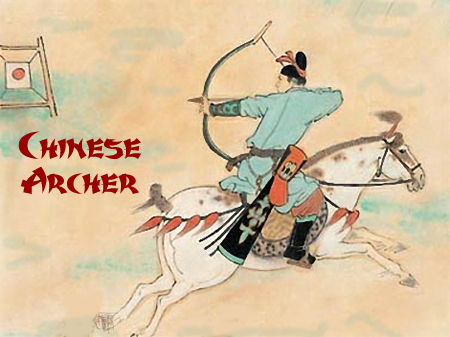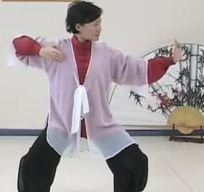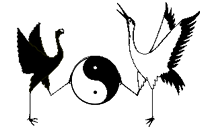Alternative Movement Names:
- Drawing the Bow,
- Pulling the Bow and Releasing the Arrow,
- Shooting the Serpent,
- Pull-Aim-Release
|
At the end of movement #1, you are standing with your feet a shoulder width apart and your hands are falling in an arc.
 This movement flows on from the first one. instead of interlocking fingers this time your hands will arc up in front of you and cross - the right hand in front of the left hand, hands relaxed and open, with your palms facing towards you. This movement flows on from the first one. instead of interlocking fingers this time your hands will arc up in front of you and cross - the right hand in front of the left hand, hands relaxed and open, with your palms facing towards you.
|
 When your arms cross you need to centre your weight onto your right leg. Lift your left foot and step out to the left into a double shoulder width horse stance. When your arms cross you need to centre your weight onto your right leg. Lift your left foot and step out to the left into a double shoulder width horse stance.
|
 By the time your hands are at the height of your face you weight should be centred between your feet. Both feet should be pointed forward and keep them flat on the floor.
The feet should be wider than shoulder width apart, but at first just make it more than shoulder width. By the time your hands are at the height of your face you weight should be centred between your feet. Both feet should be pointed forward and keep them flat on the floor.
The feet should be wider than shoulder width apart, but at first just make it more than shoulder width.
Your knees should be bent, but your back should be straight and your head should be held up straight. When you get more confident you will be able to bend your knees more and have your feet wider apart. |
You are now in the position to start the second movement.
The whole movement mimics being an archer on horseback.
Your legs are bent, feet in stirrups - parallel and facing forward, head upright, back straight. Your upper body is moved from side to side to fire arrows. You swivel at the waist - you do not turn the hips (they are planted on the saddle!). At first you will not be able to turn easily, but as you practise you become more supple and you will be able to fire arrows over a bigger range,
The movement of your arms mimics the drawing of a bow, aiming an arrow at a target, and releasing that arrow.
You need to coordinate the movement of your arms to match this image.

You have to use your imagination: feel the tension in the bow string as you draw it to fire the arrow. Imagine a target. Watch the arrow fly to its target. Concentrate on the target. |
|  Turn at the waist to face to your left. Focus on a point in the distance - the target! Turn at the waist to face to your left. Focus on a point in the distance - the target!
Extend your left arm out level with your chest. Your left hand has the palm facing away from you. The third fourth and fifth fingers must bend as if curled around  a bow that you are holding; the index finger points upwards and the thumb out out an angle of 90 degrees - to form a rest for the arrow shaft. a bow that you are holding; the index finger points upwards and the thumb out out an angle of 90 degrees - to form a rest for the arrow shaft. |
 At the same time your left arm is extending outward, you lift your right arm up to chest height to pull the string of the bow back ,curling all of your fingers around that imaginary string to do so. Your right arm bends at the elbow and then your right arm moves out to the right keeping your elbow bent. At the same time your left arm is extending outward, you lift your right arm up to chest height to pull the string of the bow back ,curling all of your fingers around that imaginary string to do so. Your right arm bends at the elbow and then your right arm moves out to the right keeping your elbow bent.
Your arms should be in a line - at chest height. You are shooting 'straight'. |
As you draw the back the string of the bow, breathe in deeply. Aim the bow and arrow, and then release the fingers of the right hand to let the arrow fly. As you release the arrow, begin to slowly breathe out and relax. |
Your fingers of the right hand open out and the hand waves, in a circular movement - palm facing outward - until you arm is extended. Your head turns to gaze at the right hand as you do this, and you straighten the knees.
Your arms are both out at the side- they then travel down in a circular path and the whole movement starts again - this time on the other side. |
Breathing during the movement
Breathe in while drawing the bow, and breathe out when releasing the arrow and repositioning the hands for the next shot. |
| This movement is repeated six times. |
Health Benefits believed to be associated with this movement
- Horse stances condition and strengthen the legs, knees, waist and back muscles.
- Squatting down works the following muscle groups: quadriceps, glutes, hamstrings, long outside muscle, calves.
- Squatting down and coming back up will improve some balancing skills and increase cardiovascular intensity.
- During arm movements: shoulders, biceps and forearms are conditioned and strengthened.
- Balance and brain functions are improved by coordinated movements.
- Stretching helps contribute to the relaxation of stiff and tense muscles.
- Standing up straight in a horse stance helps realign the back muscles and the spine.
- A clear and peaceful mind reduces negative stress on the body.
- Squatting down exercises the leg muscles including the thighs (quadriceps), hamstrings (biceps femoris), buttocks (glutes), calves (gastrocnemius), iliopsoas, and increases demands on the cardio-vascular system.
- Increased heart rate and breathing rate provide some cardiovascular benefit.
- Useful imagery can have positive effects on mental functioning and performance.
- Using both sides of the body (mirroring in a movement form) can have positive effects on the structural alignment of the body and enhance coordination.
- Slow, deep and regular breathing positively effects mood, energy levels, and alertness; as well as improving the mechanical functioning of the lungs.
Exercises the eye muscles.

Many Chinese healers believe that this exercise helps regulate and improve the kidney meridians.
|

![]()